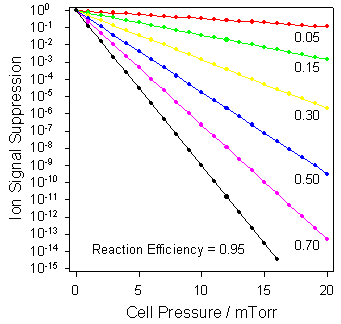Centre for Research in Mass Spectrometry

Ion Chemistry Laboratory Centre for Research in Mass Spectrometry |
 |
Data Transferability Issues: SIFT versus Reaction Cell KineticsSelecting Reaction Efficiencies
When resolving isobaric interferences in plasma mass spectrometry it is desirable to completely remove the isobar or to quantitatively tag (move to higher mass via oxidation/fluorination etc.) the analyte. Displayed at right is a graph of extent of reaction as a function of reaction cell pressure for a selection of ion-molecule reaction efficiencies. 1. Quenching of Excited States in the SIFTWhile transiting the thermalization region of a SIFT ions typically undergo ca. 105 collisions with helium buffer gas. These collisions are designed to relax the ion down to its ground state (rotational, vibrational and electronic). A Reaction Cell is typically a low pressure device where ions experience only 5-20 collisions with reagent gas molecules(atoms) and relaxation to the ground state is not necessarily as complete. Different electronic states may, but do not necessarily, have differing reactivities. 2. Ion Kinetic Energy in Multipole Reaction CellAdded translational energy in a multipole reaction cell may provide a source of energy for overcoming as much as a ca. 20 kcal mol-1 activation barrier or reaction endothermicity. 3. Clustering ReactionsIn the SIFT third body collisions with the Helium buffer gas relax nascent ion-molecule orbital complexes to a bound state. Substantially less clustering should be observed in a low pressure multipole reaction cell. |
| Ion Chemistry Laboratory, York University | 4700 Keele Street, Toronto, Ontario M3J 1P3 |